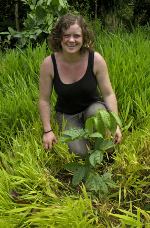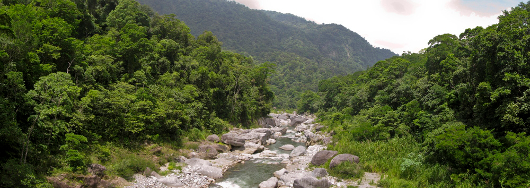Plant People
Profiles and interviews with plant people
Plant Talk in conservation with … Mike Hands and Issy Ellis-Cockcroft of the Inga Foundation
29.09.13
Hi Mike, how did you get involved in rainforest conservation?
 I’ve been a lover of nature all my life having grown up in the Cotswolds and in Cornwall, surrounded by woodlands and streams, birds and animals. I became a surveyor and while working on development projects oversees I quickly became aware of the devastation caused to tropical rainforests by slash and burn agricultural practices. The statistics speak for themselves – slash and burn accounts for a quarter of all CO2 released into the atmosphere, amounting to between 1.7 and 2.1 billion tons. However, nearly 300 million families depend upon it for their survival. In 1986 I decided to quit my job and go to Cambridge University to try and find a sustainable alternative.
I’ve been a lover of nature all my life having grown up in the Cotswolds and in Cornwall, surrounded by woodlands and streams, birds and animals. I became a surveyor and while working on development projects oversees I quickly became aware of the devastation caused to tropical rainforests by slash and burn agricultural practices. The statistics speak for themselves – slash and burn accounts for a quarter of all CO2 released into the atmosphere, amounting to between 1.7 and 2.1 billion tons. However, nearly 300 million families depend upon it for their survival. In 1986 I decided to quit my job and go to Cambridge University to try and find a sustainable alternative.
The big question was - why is the rainforest the most productive ecosystem on the planet, on the poorest soils on the planet? The answer appeared to lie in the availability of nutrients. There were many confusions and contradictions in the scientific literature at that time and I needed to determine exactly why slash and burn crops failed in the second year, hence the necessity for farmers to move on and clear a new area. I needed to find an alternative, sustainable system.
I conducted my research in secondary rainforest, on two acid soil sites, in the humid tropical lowlands of Costa Rica. I focused on the ecology of both intact rainforest and slash and burn systems. To cut a very long story short the availability of phosphorus was the key. Rainforest vegetation retrieves, conserves and recycles phosphorus but once the vegetation is cut down and removed the phosphorus is soon lost. Inga alley cropping is designed to replicate rainforest conditions. The Inga tree is the essential part of the alley cropping system because of its ability to improve the fertility of the soil, its rapid growth and germination rates and its ability to provide shade for the young crop plants beneath. When the Inga trees are pruned, the branches are used for much needed fuel for cooking and the remainder is left on the ground as a deep mulch into which the maize and beans and other crops are planted. The mulch not only provides the required nutrients but also acts as a weed suppressant eliminating the necessity for herbicides..And the Inga Foundation grew out of your findings?
Yes, our projects are all based on the finding of those long-term studies. Our aim in setting up the foundation is to provide a permanent solution to rainforest destruction and food insecurity.
We work with many partners and supporters including the Eden Project where you can now see an Inga alley cropping exhibit in their rainforest biome grown from seed brought back from Honduras in 2012.And Issy, how did you get involved with the Inga Foundation
 Mike gave a talk about the Inga Foundation and his research at my University. It looked like a brilliant project and was exactly the kind of work I wanted to get involved in when I graduated. I asked if there was any way at all that I could help the Inga Foundation, never expecting to end up in Honduras just a few months later. I started by re-making their website and setting up their blog and it all went from there.
Mike gave a talk about the Inga Foundation and his research at my University. It looked like a brilliant project and was exactly the kind of work I wanted to get involved in when I graduated. I asked if there was any way at all that I could help the Inga Foundation, never expecting to end up in Honduras just a few months later. I started by re-making their website and setting up their blog and it all went from there.
Tell us about the work you have been doing on the ground in Honduras
I spent 2 months in Honduras with the team on the ground as they worked to bring new families into the project and support farmers who were in the process of taking up Inga alley cropping. We worked to provide expertise and support to families in a number of different villages, some very remote, as well as working on getting the Inga Foundation’s new Project Centre set up.
The main part of my specific role was to document and report back to supporters and donors on the successes and achievements in Honduras so far via the website and social media.I got involved with everything that I could, while at the same time working on improving my Spanish as fast as I could as I went along.
How did you go about gaining the trust of the local farmers?All of the Inga Foundation’s team on the ground are Hondurans who are local to the area or are well known within the local communities. That means we start out with a good level of trust and respect.
After that, perhaps one of the key things is to not be afraid to get your hands dirty. The whole team, including our Honduran Director Abraham Martinez, spend as many days working out in the fields with local farmers as they can, getting stuck in measuring out Inga alleys and planting seedlings.By doing that, it makes it easier for local farmers to see that you don’t believe you are somehow better than them and are too important to get your clothes muddy. Instead it shows you recognize how much hard work is entailed in what they do for a living and helps to build up a good level of mutual respect.
Tell us a bit more about the Inga team you worked with in HondurasI worked mostly with the Honduran Director, Abraham, and Inga’s Agronomist, Luis. Both have a huge amount of experience and are clearly well-known and respected in the local communities. Driving to work, you sometime get the impression that there isn’t anyone in the whole area that they don’t know.
The communities where we work are based around the Pico Bonito National Park. Abraham studied Forestry and worked for Pico Bonito National Park Authority for a long time before joining Inga. He is passionate about conservation and the protection of the Pico Bonito rainforest. He talks about the number of times that, as a forester, he spoke to farmers slashing and burning illegally within the Park boundaries. The families would always reply that they simply had no choice; they needed to eat and they needed money for education and medicine. Abraham switched from forestry to working for the Inga Foundation because he felt that the only effective and fair way to protect the forest was to give local people another option besides slash and burn. Tell us, Mike, about your award-winning film, ‘Up in Smoke’‘Up in smoke’ is a feature length documentary by Adam Wakeling charting the work of the Inga Foundation over a three year period. It shows how we managed to build successful relationships with local farmers and their families and convince them to make the giant leap from slash and burn farming to Inga alley cropping. The film’s success has provided us with much needed funding and enabled us to employ the brilliant local professionals Issy has just talked about. We were also able to buy a plot of land and set up a Project Centre, increase the number of projects and most importantly get more farmers involved and practicing Inga alley cropping.
How will the new Project Centre improve the effectiveness of your work?
The new Project Centre at San Marcos will act as a hub where local farmers can view the demonstration areas and come for help and advice about the alley cropping system for their subsistence and cash crops. Much to our relief we had an extremely successful open day shortly after opening when farmers arrived from four different communities, some quite remote. We were especially pleased to see several women joining us as it’s really important to have the support of the whole family.
The Project Centre will also be a receiving and processing centre for sustainable, organic cash crops like pepper and vanilla, providing much needed income for very poor families.
Are there any aspects of your work that could be copied or adapted elsewhere?Work is already underway to identify other legumes that will work in a similar way to Inga in other parts of the world like West Africa, South-east Asia and Madagascar where slash and burn practices are still prevalent. It is essential that indigenous species are used to replicate local conditions..
And what does the future hold for the Inga Foundation?We will continue to grow and spread the word. Despite our successes we still have a long way to go. Alley cropping has the potential to transform the lives of slash and burn families right across the tropics and we are working hard to maximise that potential. The Inga Foundation is hoping to expand its work into Haiti where deforestation and soil erosion are widespread. Two NGO’s in Haiti have visited us in Honduras to learn more about the Inga alley cropping system.
And final, Issy, how will you continue to support the Inga Foundation now you are back in the UK?I can’t do as much as I would like to at the moment as I have my 3rd year of Uni to worry about but I am currently running the Inga Foundation’s website, facebook and Pinterest pages. Once I finish Uni, I would like to go back out to work in Honduras again for a while if I can – fingers crossed anyway!

- Mike Hands, director of the Inga Foundation has been working to halt the destruction of the Rainforest for over 20 years and is currently number 44 in the top 100 contributors to ‘saving the planet’. If you would like to know more please go to www.ingafoundation.org